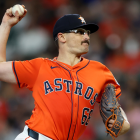
Major League Baseball officially revealed Friday that there will be some high-profile rule changes for the 2023 season. The rules contain details upon intricacies, but the "yada yada yada" version is:
- The bases will be bigger
- There will be a pitch clock
- Shifts are banned
I'm a huge proponent of all three and have been for years. I actually did some digging and found my personal push for a pitch clock dates back in 2011. It took until Jed Lowrie set me straight in 2018 before I was on board with limiting the shift. Once I heard about the bigger bases, it was a no-brainer.
The ultimate, over-arching goal with these changes is to make baseball more exciting and more aesthetically pleasing to the largest audience possible. The rules attack issues from different angles, but the goal is the same.
On that goal, though, there's still a missing piece. We'll get to that. You just have to be patient, much like we've had to be these last two decades with watching batters take an eternity to get in the box only to see pitchers match that eternity while they stare at home plate.
Here's why I like the rule changes and how they'll make the game better before we get to the great reveal.
Larger bases
There isn't much discussion needed here. At least there shouldn't be. Players today are far larger than they were when the current base size was drawn up. As such, their feet are bigger and there's less of the base to work with. Bigger bases alleviate some of the involved safety issues while also, maybe (hopefully!) triggering more attempted stolen bases and other risk-taking on the basepaths.
Aside from that stuff, we probably won't even notice when watching on TV or in person. We can safely move on.
Pitch clock
Have you ever watched a game from a few decades ago? The average game time in 1984, for example, was two hours and 39 minutes. This season, it's three hours and seven minutes. I'm still perfectly pleased with three-hour games, but there are some pretty damn tedious games that reach upwards of four hours and it's especially a problem in the playoffs when we're fighting for the eyeballs of casual fans.
The biggest problem there isn't the actual time of game. The on-field action is great, too, when we get it. The most amazingly stupendous game I ever saw in person took five hours and 17 minutes. I couldn't stop alternating between an exaggerated smile and just sitting there with my eyes wide open in astonishment over what I just witnessed. It was Game 5 of the 2017 World Series.
That game also ended at 1:38 a.m. ET on a traditional "work" and "school day."
This means an awful lot of people who otherwise would have shared my reaction didn't get to see the last portion of the game, whether in the Eastern or Central -- or even Mountain, depending upon what time people like to get to bed -- time zones.
This is, clearly, a special example, but there's a point. When trying to get the most eyeballs possible, MLB is looking to eliminate needless down time.
We'll now circle back to my question on watching games from multiple decades ago. Generally speaking, hitters didn't mess around outside the batter's box much. They just dug in. Pitchers didn't sit there and stare at home plate for more than a half minute. They just took the sign and pitched. There are always exceptions to the rule, both back in the past and with throwbacks in our current game, but, as I said, generally speaking, players take far more time nowadays doing essentially nothing.
The pitch clock cuts out some of the dead air.
Now, a few seconds per hitter might not seem like much, but if you start to add up every single pitch to every single hitter over the course of nine or more innings, we're talking about a good portion of time.
The problem isn't long, action-packed games. No one is saying it is, Mr. Strawman. The problem is how much dead air could be cut. I'd be willing to bet the pitch clock in my favorite game over the course of 10 ridiculous innings would have cut out around a half hour. That's a win for everyone.
Back in the 2016 NLCS, I started pushing to limit mound visits. MLB implemented a mound visit limit before the 2018 season. I saw lots of discourse about it that offseason and then maybe the first few series of the year. Interestingly, I pretty much never see or hear complaints about it anymore. I believe this is where any complaints on the pitch clock are headed.
The league has been testing the pitch clock in the minors for years, too. One of the things that most stood out to me in attending games with the clock was how little I noticed it. The first inning of the first game, I glanced up to find the clock a few times, just for the novelty of it. After that, I stopped looking because it wasn't compelling. It just didn't really matter. After a while, you just realize the game moves along much more quickly. It's glorious.
I'm confident enough here to say any problems are quickly ironed out. It's going to be a big win for fans.
Banned shifts
Since 1908, the lowest seasonal batting averages were in 1967 (.242) and 1968 (.237). As a result, Major League Baseball realized the pitchers were too good and it lowered the mound. The batting average this season is .243.
A decent part of that has to do with the defenses. The players have better arms than ever, so the infielders can play deeper and get to more grounders while still being able to throw the runner out at first. The advanced scouting is better than ever, too, so the defenses are expertly tailoring themselves to prevent a good portion of balls in play from finding an unoccupied home on the field.
For me, there's another aspect at play, and it's aesthetics. I just don't particularly care for seeing four or five defenders blanketing the outfield. I can't stress how much I hate seeing a line drive right back up the middle -- which has always felt like such a good at-bat for the hitter -- being gobbled up by a defender just standing there like a "rover" back in pee wee ball. I've been tongue-in-cheek saying on Twitter for years that one of our biggest crimes is a well-struck ball up the middle not being a hit.
I know I'm not alone because I've discussed this so many times with many different crowds of baseball fans. There is certainly a divide and this is a polarizing topic, but by no means does one side have a super-majority or anything. There are swaths of baseball fans who hate seeing players away from the vicinity of traditional positioning.
As I said above, I used to be anti-ban, but I was convinced to change my stance after having a decently-long discussion with Jed Lowrie. One of his main points was a second baseman (or shortstop or third baseman shifting to the other side of the field) standing in the middle of right field means that the right fielder can basically stand on the warning track. So a line drive to shallow right field, which feels like it should be a single, is now caught with ease. And a liner off the wall, which should be a double or triple, is now caught with ease. As Lowrie phrased it to me, either of those described balls just feel like they are supposed to be wins for the hitter. There's basically no room between them either.
This is where the pro-shifting side will jump in and say there's a mechanism for offenses to avoid the shift.
It's ... "hit 'em where they ain't!" Bunt them out of the shift if you need to. Quit trying to pull everything. Quit trying to only hit home runs and instead shorten up and go the other way.
I think I hit most of the talking points. I get it. I used to be there and I'd consider them fair points if the players had more control over the situation. They just don't anymore.
Back in the early 1980s, a hard-throwing pitcher could sit around 92-93. Pitchers who threw upper-90s like Nolan Ryan and, much further back, Bob Feller and a few others were outliers. There's a reason they were so famous! They were totally uncommon and they struck out ungodly numbers of hitters in those days because of it.
Sitting 92-93 is average for starting pitchers now. The hardest throwers can hit that level of velocity with off-speed pitches. There are more versions of breaking pitches than ever to the point that we're saying things like "sweeper" -- no, not a vacuum cleaner -- and "splinker." Running cutters hit triple digits now. Those "exploding sliders" Crash Davis mentioned in the late '80s are now coming in with a "91" showing on the JUGS radar.
I can't help but chuckle at someone who hasn't played baseball in years sitting around lamenting "approach" when a hitter doesn't place a 93-mph slider exactly where he wants on the field. Let's be real: It's a miracle that pitch is ever even fouled off, let alone put in play for a hit. You can bring up all the high-batting average heroes you want from multiple decades ago, but they never saw pitching like this.
Speaking of which ...
The pitchers are still too good
This is the one problem I mentioned that MLB hasn't adequately addressed. The league did crack down on the so-called "sticky stuff," and that's good. The pitchers are already good enough that permitting them to cheat wasn't really what was best for business.
I maintain that limiting the shift is ultimately going to be for the best of the game, but I'm open to disagreement. I can see the argument for letting the defense do whatever it wants. Hell, I used to believe it, as I said above.
The biggest issue isn't the batting average on balls in play, though. It's .290 this year and that's not absurdly low, even if we could argue it should, in a perfect world, be closer to .300.
No, the biggest issue would be the strikeouts.
We can skip the argument about "these players nowadays" and their "approach" at the plate and the nonsense about how they don't care about striking out. Every single player hates striking out. I don't know why so many people like to make stuff up just to comfort themselves that the players now are so mentally inferior than "back in my day," but it sure happens a lot.
No, the reason strikeouts are higher now than they have ever been is because of what was mentioned at length above. The pitchers are better than ever. They throw harder, they have better command and control (if you don't believe me, look up Ryan and Feller's walk totals), they have better off-speed pitches than ever before, and there's an assembly line of stud relievers waiting in the wings to make sure players don't get too many looks per game at individual pitchers.
On the latter point, it's pretty common knowledge that it's better for the hitter the more times he and a pitcher see one another. It's why in this day and age teams limit starting pitchers so often. Even if people like me don't like this aspect of game-planning and praise Sandy Alcantara for being so good at getting deep into games, we have to understand it.
The first time hitters see starting pitchers this season, they are hitting .237/.303/.382. The slash line goes to .250/.311/.413 the second plate appearance and .264/.324/.442 a third time. Again, it's not complicated from a game-planning standpoint to shield pitchers from the third-time-through penalty.
We don't have a full season of data yet, but last season, there were 19,510 plate appearances where an offensive player saw a starting pitcher for the third time. In 2001, with the same number of games and teams, there were 31,619 plate appearances when a batter saw a starter the third time in a game. Hell, there were over 5,000 where the batter saw a starter for a fourth time 20 years ago. The number per game where a hitter saw a pitcher three or four times only increases the further back we go in history.
That is to say that in addition to pitchers having much better stuff than ever before, hitters are at an ever-increasing disadvantage when it comes to getting multiple looks at said stuff.
For whatever reason, it seems to be much less satisfying for so many people to hear, but it's really this simple: It's the pitchers.
No, It isn't approach or teaching or the deterioration of today's hitters being students of the game or anything like that. There's no need to brand today's player as some sort of inferior being to the hitter of yesteryear. It's just that much harder to put the bat on the ball in today's game and, when a player is fortunate enough to do so, it's that much harder to control where it's hit. And even if it's one of the best hitters at controlling where he puts the ball, he's dealing with better defenders who are better positioned than ever before.
There is an answer, too. The league has discussed it, but hasn't gotten seriously close to implementation.
Here at CBS Sports, it hasn't been just me driving this train. My colleagues R.J. Anderson, Mike Axisa and Dayn Perry have joined me for years in calling for lowering the mound, moving the mound back, or both. We aren't even talking anything drastic. Just a few inches lower and maybe a foot further away from home plate probably does the trick.
No, Mr. Strawman, the goal isn't to coddle today's players or feel sorry for them or anything like that. The goal is to maximize the on-field action in baseball. The strikeout problem is not going away by complaining about approach or branding the current players things they aren't. The pitchers are just, physically, as a collective group, that amazing.
Lowering the mound and/or moving it back will help make inroads there.
In the meantime, the pitch clock will kill a good amount of the dead time and hopefully limiting the shift provides us with more singles, doubles and triples to enjoy.






















